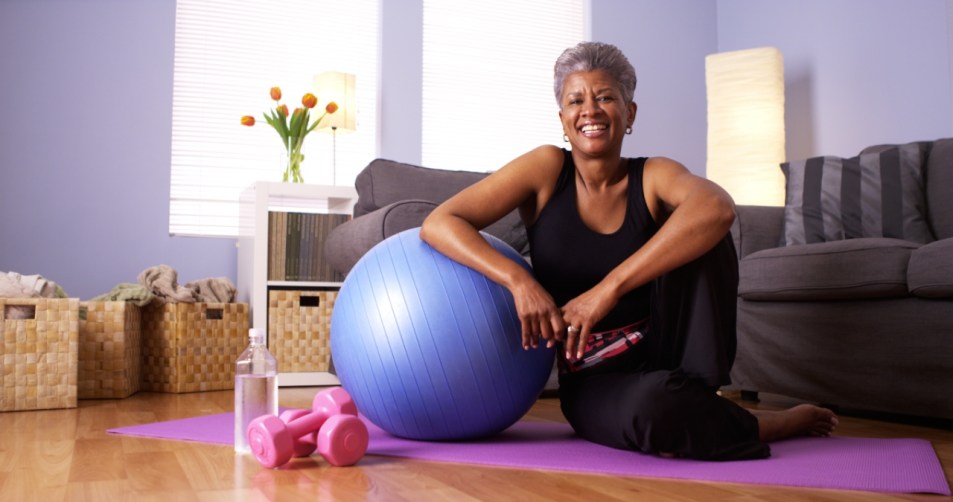Make the Most of Your Workouts With These 8 Mindfulness Hacks
Focus in on your fitness.

During a workout, many people go into autopilot, letting their minds wander as they move their bodies, challenge their muscles, and get their hearts pumping faster. And while there are times when zoning out can be helpful, staying mindful as you move can bring a surprising array of perks, regardless of the type of physical activity you’re doing. That’s right — mindfulness isn’t just for yoga anymore! You can practice mindfulness when you’re walking, running, cycling, swimming, or even engaging in strength training.
What physical and mental health benefits does mindfulness have?
Though there are many ways to practice mindfulness in your workouts, all involve focusing on
the present moment — on what you’re doing and how you’re feeling, without judging yourself or your performance. The idea is to engage both your mind and body as you hone in on your exercise intentions, the specific muscles you’re working, and how you’re feeling as you move.
In addition to improving the quality of your movements, which in turn decreases your risk of injury, this approach can help you feel more connected to your physique; which is satisfying in and of itself. “If you’re focusing on executing the moves and paying attention to how you feel as you do so, it helps improve the quality of your workout and enables you to perform better,” explains Megan Cannon, PhD, a sport psychologist based in Allentown, Pennsylvania.
Taking a mindful approach to exercise can also improve your overall outlook, as well as your psychological health, says Cedric Bryant, PhD, president and chief science officer for the American Council on Exercise. In fact, a study published in Psychology of Sports and Exercise found that when students engaged in mindful movement, they experienced fewer feelings of stress, anxiety, and depression than when they were sitting down. “This may be partly because bringing mindfulness — or intentional awareness — into your workouts allows you to shift your focus from all the noise we’re inundated with and all the issues that are vying for our attention and focus on the muscles you’re engaging, your breathing, and what you’re trying to accomplish,” Bryant adds.
Rather than just going through the motions, engaging in conscious movement and maintaining a high level of awareness of what you’re doing can help you enjoy your workouts more. A study published in the Journal of Sport & Exercise Psychology found that when people exercised at a vigorous intensity then gradually and deliberately decreased the slope of their intensity and focused on how their bodies felt during the transition, they enjoyed the workout more and remembered it with greater pleasure. The enjoyment factor can even help you keep coming back to the gym. People who successfully maintain their exercise regimens score higher on measures of mindfulness and acceptance, and a study in the Journal of Health Psychology suggests that engaging in mindfulness makes people rate exercise as more fun and something they’ll be more likely to make a habit.
8 Mindfulness Steps
Here’s even better news: You don’t need a mindfulness guru to bring the practice to your workouts. Just follow these eight simple steps to infuse a healthy dose of mindfulness into your exercise routine,
1. Set an intention before each session.
Before you start moving, think specifically about what you want to get out of this particular exercise session, Bryant advises. Do you want to boost your energy for the rest of the day? Increase your stamina for the long haul? Blow off steam and relieve stress? Let loose and have fun? Set yourself up for a better night’s sleep? During the workout, remember why you are investing in this fitness time, and you’ll help yourself get what you came for.
2. Focus on your breath.
Concentrating on the rhythm of your breathing helps you stay attuned to the present moment and helps connect your mind and body. If your mind starts to wander during your workout — perhaps to all the items on your to-do list or to what you’re going to cook for dinner — simply bring your attention back to the pattern of your inhale and exhale. Your breath can help anchor you to the here and now, Cannon explains.
3. View each workout with fresh eyes.
“Come with a beginner’s mindset and see the workout as new and different — enter with no expectations about what it’s supposed to look like or how it’s supposed to feel,” suggests Beth Jordan, an American Council on Exercise personal trainer and RYT 500 yoga teacher in Jacksonville Beach, FL. “This will free your body and mind so there’s more connectedness,” and it will help you enjoy the experience without worrying about your performance.
4. Acknowledge your ability.
One of the key elements of mindfulness is acceptance. In other words, recognize the way things are and don’t focus on the way you think they should be, Jordan says. During an exercise session, try to appreciate your speed, strength, or stamina for what it is today, without judging. “Accept where you are instead of fighting against it,” Cannon advises. If you catch yourself criticizing your performance during a workout or comparing yourself to others in a group exercise setting, acknowledge those thoughts, place them to the side, and return your attention to what you’re doing.
5. Attend to your alignment.
Maintaining the correct form and posture throughout a particular physical activity helps optimize the flow of blood, oxygen, and energy to the right areas of the body. But this doesn’t happen automatically: It takes a concerted effort to move with proper form. “In exercise classes or personal training sessions, people become reliant on others to give them cues about form and posture,” Bryant says. It’s important for you to take responsibility for focusing on your form and posture in order to improve the quality of your movements. (If you’re not sure what the proper form looks like for a given activity, ask an exercise instructor or trainer for pointers.)
6. Notice your surroundings.
If you’re exercising outdoors, tune into the sensory elements of the environment around you. How does the air or sunlight feel against your skin? What aromas do you smell? What do you hear? This exercise in mindfulness can bring an added dimension of enjoyment to your workouts.
7. Express appreciation to your body.
Periodically during your workout, let yourself “feel gratitude for your ability to do this form of physical activity, for taking you through the workout,” Jordan suggests. Similarly, at the end of the workout, thank yourself for showing up for yourself and doing the workout. (“Saying it out loud makes it more concrete,” she says.) Besides ending the session on a positive note, intentionally appreciating your body and mind for what they just accomplished can serve as positive reinforcement and motivation to keep up the good work in the future.
8. Tune into your body sensations.
As you move, focus on the parts of the body that are engaged in the activity you’re doing, noting where you feel tension or freedom of movement, Bryant suggests. In other words, don’t let your workouts become an out-of-body experience: Regularly check in with how you’re feeling and which muscles, joints, organs, and other tissues are working hard. While running or walking, for instance, you might note whether each leg’s stride length is the same; while cycling, you might check to see if both legs are doing their fair share of the work (or whether one leg is basically going along for the ride).
Bryant also recommends experimenting with creating tension in various muscles, then consciously relaxing them as you move. “This helps you learn how to activate and relax those muscle groups, which promotes the relaxation response,” he explains. Plus, if you pay attention to how your body is responding to the activity, you can push yourself a little harder if you feel like it.
4 Physical Activities To Infuse With Mindfulness
You can approach any type of exercise with a mindful attitude. The keys are to stay open and non-judgmental about the experience and attuned to your breathing and bodily sensations. Here’s how to infuse various physical activities with mindfulness:
Swimming
Notice how the water feels against your body, from your head to your toes, as you swim. Or get into a rhythm by linking your breathing rate with your stroke pattern. Try to notice whether one side of your body engages in stronger strokes — or tune into how your breathing pattern changes the longer you swim.
Cycling
Take turns driving your pedal strokes with each leg: Let your right leg do all the work for 20 seconds while your left leg goes along for the ride; then, switch the work to your left leg for 20 seconds while your right leg relaxes. Similarly, you can alternate focusing on the downstroke or the upstroke as you pedal or on making your pedal strokes super smooth.
Running
Tune in to the rhythm of your feet as they hit the ground and let that serve as a focal point. Or concentrate on lengthening your stride length or rate and notice how your breathing changes with the additional challenge.
Walking
As you stride outside, engage your senses, focusing on the sights, smells, and sounds around you. Turn your attention to how your arms swing and your legs move as you walk; notice how the ground feels as each foot makes contact with it and pushes off to propel you forward.
A version of this article appeared in our partner magazine Mindfulness for Women.
For more on how mindfulness can improve your life and how to do it:
Mindful Eating Can Be A Food Lover’s Secret to Automatic Weight Loss, Say Psychologists
This 5-Minute Mindfulness Meditation Will Break Your Worry Cycle













